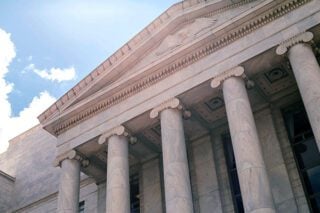
Last Friday, Kaiser Gypsum, Inc. – a manufacturer of construction and remodeling materials such as asbestos drywall, joint compound, textured paint, and various related products – filed for bankruptcy in the United States District Court for the Western District of North Carolina. The primary reason, according to the documents submitted by Kaiser Gypsum, is the number of asbestos and mesothelioma lawsuits that have been levied against the company over the last four decades.
In one motion, the company acknowledged that it had been named as a defendant in more than 38,000 asbestos-related lawsuits since the late 1970s. As of a month before the bankruptcy petition, the company still had around 14,000 pending lawsuits related to its liability for the asbestos products that it had created in the 1950s through the 1970s, according to the court records reviewed by the Mesothelioma Cancer Alliance.
Kaiser Gypsum and Asbestos
Started in 1952 by Henry J. Kaiser, Kaiser Gypsum is mainly known for the production of gypsum wallboard (also known as drywall), as well as related materials including plaster, lath, fiberboard, and an assortment of construction accessories such as joint compound and textured paints. Right from its inception, the company knowingly used chrysotile asbestos in some of its products.
Although asbestos was linked to a variety of medical problems for many years, scientific proof of the connection between asbestos and diseases like mesothelioma was not obtained until the 1960s. Companies like Kaiser Gypsum would use asbestos in their products due to its inexpensiveness as well as to take advantage of some of the fire- and heat-resistant properties of the naturally occurring mineral.
In the 1970s, Kaiser Gypsum’s use of asbestos in joint compounds and other products opened it up to liability litigation. Lawsuits were filed by those who had developed mesothelioma or other asbestos-related diseases – or their families – and for many years the company fought the allegations of liability. Over the decades, the company has had to pay hundreds of millions of dollars, if not more, to victims of asbestos exposure through settlements and verdicts as a result of these lawsuits.
Creating an Asbestos Trust Fund
Given the thousands of asbestos lawsuits still pending against the company, Kaiser Gypsum (along with its parent company, Hanson Permanente Cement, Inc.) is now attempting to seek an end to its liability. According to documents filed in the Western District of North Carolina, the company wants to establish a new asbestos trust fund that would pay existing and future claims due to the company’s exposure of asbestos to employees, customers, and others.
In most cases, asbestos trust funds require a relatively simple claims process to be completed by the mesothelioma patient or the patient’s family. Upon meeting eligibility requirements, patients receive money from the trust fund to help pay for things like medical bills, travel costs associated with care, and lost income due to time taken out of work to receive care.
Asbestos trust funds are legal entities authorized by section 524(g) of the U.S. Bankruptcy Code. Essentially, as part of the Chapter 11 reorganization, Kaiser Gypsum would create an independently operated trust and fund it with enough money to pay out pending claims, as well as expected future claims, due to the company’s asbestos liability. In exchange, the company itself would no longer be legally liable for the asbestos exposure it caused when making and distributing asbestos-containing materials in the 1950s – 1970s.
The first asbestos trust fund was set up in the 1980s by the Johns-Manville Corporation, after that company went bankrupt due to the large number of asbestos lawsuits brought against it. Since then, many other trust funds have been established in similar bankruptcy proceedings. Today, there are approximately 60 trust funds still actively paying asbestos claims.
Concerns About Kaiser Gypsum’s Bankruptcy
Given Kaiser Gypsum’s recent bankruptcy filing, there are a number of concerns to watch out for.
First of all, the initiation of bankruptcy proceedings on September 30 is the first action in what will likely be a long series of legal actions. Ultimately, these actions will lead to the reorganization of the company and the development of an asbestos trust fund, if the company’s bankruptcy plan is approved by the government. However, this process could potentially take years, during which time individuals who have mesothelioma due to asbestos exposure caused by Kaiser Gypsum products could pass away, given the disease’s poor prognosis and low rate of survival.
Another concern is that any trust fund established by the company during its reorganization should contain enough money to pay out the approximately 14,000 pending lawsuits against it. It should also be funded with enough money to pay future claims, so that it does not run out of money designated for mesothelioma victims, as other asbestos trust funds have in the past.
The Mesothelioma Cancer Alliance will continue to watch the bankruptcy proceedings of Kaiser Gypsum, Inc., and report on how they are moving forward. In the meantime, if you or a loved one has been exposed to asbestos through the use of Kaiser Gypsum products and diagnosed with mesothelioma, please learn more about your legal rights by talking to an experienced mesothelioma lawyer.


